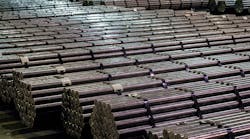The World Steel Association forecast global steel demand will rise 2.3% in 2023 to 1.82 billion metric tons, and then improve further by 1.7% to 1.85 billion metric tons for 2024. The new Short Range Outlook report increases expectations slightly from the forecast issued last October, but the trade association cautioned that high interest rates will continue to restrain steel demand.
Further, World Steel anticipates that economic growth will slow in China, the world’s largest steel-producing nation. Despite improving conditions since last fall, China’s results will affect steel-demand overall.
World Steel is a trade association with members in 63 countries, who represent about 85% of global steel capacity.
“Persistent inflation and high-interest rates in most economies will limit the recovery of steel demand in 2023, despite positive factors like China’s reopening, Europe’s resilience in the face of the energy crisis, and the easing of supply chain bottlenecks,” according to Máximo Vedoya, who is CEO of steelmaker Ternium and chairman of World Steel’s Economics Committed.
He continued: “In 2024, demand growth is driven by regions outside China but faces global deceleration due to China’s anticipated 0% growth, overshadowing the improved environment. Sustained inflation remains a downside risk, potentially keeping interest rates high.”
The current expectation is that – having fallen -3.5% in 2022 – Chinese steel demand will rise 2.0% this year but then remain flat in 2024. The results within China are relevant to the world forecast because Chinese steelmakers typically produce more than half of all the steel in the world.
China’s outsized role in determining steel demand is changing, however. “As China’s population declines and moves to consumption-driven growth, its contribution to global steel demand growth will lessen,” according to Vedoya. “Future global steel-demand growth will rely on reduced drivers, primarily concentrated in Asia. Investments in decarbonization and dynamic emerging economies will increasingly drive positive momentum for global steel demand, even as China’s contribution to global growth diminishes.”
World Steel foresees steel demand in advanced economies (North America and Europe) recovering from contraction in 2022 with a 1.0% rebound in 2023, and then a further 3.2% increase in 2024.
Total U.S. steel demand fell 2.6% in 2022, but should rebound by 1.3% in 2023 and then again by 2.5% for 2024.
The U.S. economy’s “post-pandemic” economic rebound ended in 2022 thanks to the Federal Reserve Bank’s increases in interest rates, and that issue is joined now by higher costs for land and raw materials: All these factors are impacting construction and manufacturing sector growth, depressing steel demand.
Infrastructure investments will drive some U.S. steel demand through 2023 and 2024, as will new energy-sector investments.
U.S. car and light vehicle sales are seen increasing 8.0% in 2023 (reversing the 2022 result) and then a further 7.0% in 2024. Even so, that improved performance still would place U.S. auto sales at 6.0% below the 2019 result.






